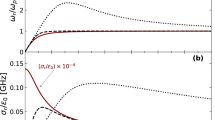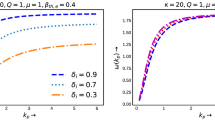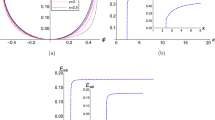Abstract
FOLLOWING the methods adopted by Boot et al. 1, we have recently undertaken an analysis of the conditions required for the containment of an ionized plasma by electromagnetic waves at high frequency, taking collisions and space-charge forces in the plasma into account. During this work, now being prepared for publication, one of us (H. G.) directed attention to the fact that two types of confining force are present when the plasma interacts with the wave in the presence of large field gradients. One is due to the electric, or induced electric, field acting directly on the electrons, as analysed by Boot et al. For this force to be unidirectional, certain relations between amplitude, gradient and frequency of the electric field and electron density must be fulfilled. We call this the Mathieu force, since these relations may be obtained by examining the differential equation which is of the Mathieu type2. The other unidirectional force we call the electromagnetic force. This force results from the interaction of the electron current set up by the electron moving in the electric field with the magnetic field component of the electromagnetic wave. This is the force considered by Volkov3.
This is a preview of subscription content, access via your institution
Access options
Subscribe to this journal
Receive 51 print issues and online access
$199.00 per year
only $3.90 per issue
Buy this article
- Purchase on Springer Link
- Instant access to full article PDF
Prices may be subject to local taxes which are calculated during checkout
Similar content being viewed by others
References
Boot, H. A. H., Self, S. A. R., and Shersby-Harvie, R. B., J. Electronics and Control., 4, No. 5, 434 (May 1958).
McLachlan, N. W., “Theory and Application of Mathieu Functions” (Oxf. Univ. Press, 1951).
Volkov, T. F., “Plasma Physics and the Problem of Controlled Thermonuclear Reactions”, 3, 395 (Pergamon Press).
Self, S. A., and Boot, H. A. H., J. Electronics and Control, 6, 499 (1959).
Dutt, T. L., and Stainsby, A. G., Fourth Int. Conf. Ionization Phenomena in Gases, Uppsala, 1959, 2, Part III, 755.
Haaland, C. M., Phys. Rev. Letters, 4, No. 3, 111 and 112 (Feb. 1, 1960).
Watson, W. K. R., Nature, 185, 449 (1960).
Glagolev, K. M., Yeliseyev, G. A., and Khilil, V. V., Proc. Second Int. Conf. Peaceful Uses of Atomic Energy, p. 2501 (1958).
Author information
Authors and Affiliations
Rights and permissions
About this article
Cite this article
GALLOP, J., DUTT, T. & GIBSON, H. Forces on Charged Particles of a Plasma in a Cavity Resonator. Nature 188, 397–398 (1960). https://doi.org/10.1038/188397a0
Issue Date:
DOI: https://doi.org/10.1038/188397a0
Comments
By submitting a comment you agree to abide by our Terms and Community Guidelines. If you find something abusive or that does not comply with our terms or guidelines please flag it as inappropriate.



